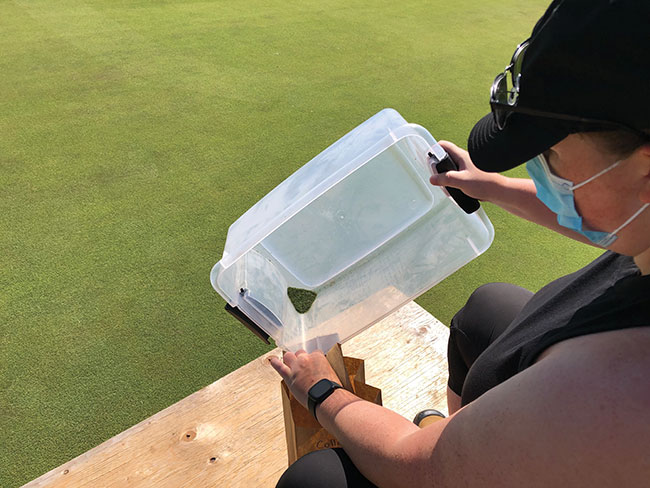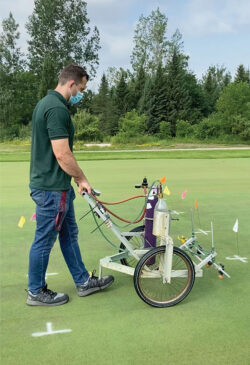
Features
Agronomy
Turf Revival
The important role played by plant growth regulators
PGRs have revolutionized turf management practices over the years and have improved environmental sustainability
October 17, 2023 By Dr. Sara Stricker
 Clippings are weighed to determine growth rate suppression by PGRs.
Photo credit: GTI
Clippings are weighed to determine growth rate suppression by PGRs.
Photo credit: GTI Turfgrass management has evolved significantly over the years, with an increasing focus on sustainability and resource conservation. Among the tools that have revolutionized turf management practices are plant growth regulators (PGRs).
PGRs are synthetic or naturally occurring compounds that regulate plant growth and development.
PGRs can influence various physiological processes in plants, ultimately altering their growth and development. These compounds can be broadly classified into five categories: auxins, cytokinins, gibberellins, abscisic acid, and ethylene. Each PGR has specific effects on plant growth, which can be harnessed to optimize turfgrass management practices. There are three big reasons why PGRs can improve environmental sustainability of turfgrass management.
Reduced mowing frequency
Trinexapac-ethyl (TE) and flurprimidol (FLP) are two widely used PGRs that inhibit the production of gibberellins, a group of plant hormones responsible for cell elongation. By suppressing gibberellin production, these PGRs effectively reduce vertical growth in turfgrass, resulting in a more compact and uniform turf canopy. Paclobutrazol (PAC) also inhibits gibberellin biosynthesis while also reducing cytokinin levels. This dual action decreases vertical growth and encourages tillering in turfgrass, resulting in a denser turf stand. Prohexadione-calcium (PHC) inhibits gibberellin and prevents lodging, which is important for seed production.
The reduction in turf growth rate is typically quantified by measuring the weight of clippings. Interestingly, a recent study at the University of Georgia suggests that cultivars of creeping bentgrass responded differently to TE, with V-8 exhibiting the lowest response rate compared to Penncross, L-93, 007, and Tour Pro (Henry et al. 2022). This suggests that the efficacy of other PGRs might also vary by cultivar. Overall, reducing the turf growth rate will reduce the frequency of mowing which in turn cuts down on labour, emissions, and equipment wear-and-tear.
Improving stress tolerance
Abscisic acid (AA) is a naturally occurring plant hormone that plays a vital role in stress responses, including drought tolerance. Applying ABA-based PGRs can enhance the plants’ ability to survive through hot and dry summer conditions.
If applied before drought stress, the application of AA can mean that the turf stays lush and green for longer than the untreated control. In fact, the use of AA or TE on Kentucky bluegrass and creeping bentgrass resulted in higher soil volumetric water content, leaf water content, and improved growth rates throughout drought stress (McCann and Huang, 2008). ABA is currently used in the production of grapes and other fruit crops, but a commercial product has not been developed for turf. In general, the reduction in vertical growth due to this PGR translates to lower water use and improved photosynthetic efficiency.
Nitrogen use efficiency
Turfgrass often receives significant nitrogen inputs to maintain a lush green appearance and density. PGRs can improve nutrient use efficiency and reduce the need for nutrient inputs. In a three-year study in New York, the application of TE to a creeping bentgrass green reduced vertical growth, which then reduced mowing frequency, which thus reduced nutrient loss by clipping removal. This trickle-down effect meant that the putting green needed 25¬–50 per cent less nitrogen (Kreuser and Soldat, 2012). This is great news for environmental sustainability and your budget. Although the price of fertilizer has leveled out, we are still seeing nitrogen prices higher than pre-pandemic years.

PGR treatments are applied.
Photo credit: GTI
Can PGRs be used on turf in Canada?
Prohexadione-calcium = approved
In the recent environmental assessment required by Health Canada for product registration, PHC was deemed unlikely to cause risk to the environment. The health effects seen in animals from PHC only occurred when doses were 100 times higher than that of the label rate. In addition, the amount of transfer was drastically reduced when the spray residues are dry. Due to these factors, PHC was approved for use on golf courses, sod farms, sports fields, municipal sites, and cemeteries.
Trinexapac-ethyl = limited use
In 2022, TE was approved for use only on golf courses, sod farms, and to produce perennial ryegrass seeds. Unfortunately, according to the toxicology studies, exposure to TE can result in neurological symptoms, chronic toxicity, and damage to kidneys, and loss of pregnancy for rats. The use of TE on turf in residential areas (lawns, parks, playing fields, etc.) is prohibited due to the risk to children and pregnant women. If you are using this product, please refer to the label for proper protective equipment, especially when mixing and loading.
Flurprimidol, Paclobutrazol= no
FLP is not yet registered for use in Canada, but PAC has been registered for greenhouse use on ornamentals in containers.
Abscisic Acid = ?
This naturally occurring plant hormone has been known in the world of plant sciences for many years, but a commercial product containing AA has yet to be marketed for turf. Plants will naturally produce AA in response to drought or freezing conditions to survive through stress. Perhaps this is the next frontier of PGRs?
At the Guelph Turfgrass Institute, a study by Dr. Eric Lyons and John Watson confirmed that Anuew (PHC) and Primo Maxx (TE) can both effectively reduce creeping bentgrass growth rate on a putting green without causing stress symptoms such as yellowing and etiolation. When comparing a calendar schedule (four weeks) to a Growing Degree Model schedule (300 GDDs), the GDD schedule recommended five applications of the PGRs between June 4 and Aug. 6. The calendar method resulted in four applications. Between the two schedules, timing applications using GDD resulted in more consistent growth suppression (Lyons and Watson, 2021).
In conclusion, plant growth regulators have become indispensable tools in modern turfgrass management, offering sustainable solutions to improve turf quality and resource efficiency. Supported by scientific research, the proper application of PGRs can lead to water conservation, reduced nutrient inputs, enhanced stress tolerance, and overall improved environmental turfgrass management.
Turf managers and the public should continue to advocate for alternative management options, to encourage innovative companies to develop and register new products in response. The future of grass is looking greener!
You can contact the Guelph Turfgrass Institute at GTI@uoguelph.ca or follow @GuelphTurf on social media.
Works cited:
- Henry, G. M., M. Moore, K. A. Tucker. 2022. Response of creeping bentgrass (Agrostis stolonifera) and weed species to plant growth regulators. International Turfgrass Society Research Journal 14(1): 791–796.
- Kreuser, W. C., D. J. Soldat. 2012. Frequent trinexapac-ethyl applications reduce nitrogen requirements of creeping bentgrass golf putting greens. Crop Science 52: 1348–1357.
- Lyons, E., J. Watson. 2021. Comparing plant growth regulators: Anuew, Primo Maxx and an experimental on a USGA putting green. GTI Research Report: 1–14.
- McCann, S. E., B. Huang. 2008. Drought responses of Kentucky bluegrass and creeping bentgrass as affected by abscisic acid and trinexapac-ethyl. Journal of the American Society for Horticultural Science 133(1): 20¬–26.
Dr. Sara Stricker is the communications and outreach co-ordinator at the Guelph Turfgrass Institute.
Print this page